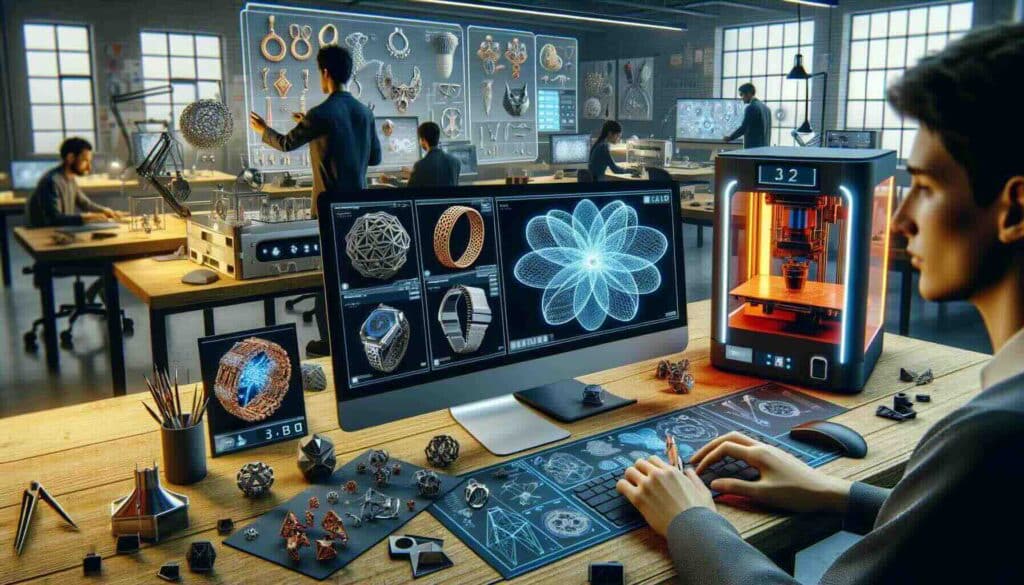
Creativity and innovation are crucial in the rapidly evolving world of industrial design. Industries such as jewelry and home appliances constantly seek ways to enhance their design processes to create aesthetically pleasing and functionally superior products. Artificial Intelligence (AI) is a transformative force redefining industrial design creativity. This article explores how AI revolutionizes jewelry and home appliance design processes by integrating topological optimization and other advanced tools. We will focus on leading CAD software: CREO from PTC, CATIA, and SolidWorks from Dassault.
AI and Industrial Design: A Creative Revolution
AI’s role in industrial design extends beyond automation and efficiency. It brings a new dimension to creativity by enabling designers to explore unconventional ideas and optimize designs in ways previously unimaginable. Topological optimization is one of AI’s most promising applications in this realm. This method optimizes material layout within a given design space, subject to specific constraints and performance criteria.
Topological Optimization: Redefining Design Possibilities
Topological optimization uses advanced algorithms to determine the most efficient material distribution for a given set of constraints. By integrating AI, this process becomes more intuitive and powerful. AI-driven topological optimization can analyze vast datasets, learn from previous designs, and suggest innovative solutions that balance aesthetics, performance, and manufacturability.
AI can revolutionize the creative process in the jewelry sector, where intricate designs and material efficiency are essential. For instance, designers can input basic design parameters into AI-driven topological optimization tools, generating multiple design iterations. These iterations are structurally sound and exhibit unique aesthetic qualities that may not be achievable through traditional design methods.
Elevating Jewelry Design with AI
Jewelry design is an art that demands precision, creativity, and attention to detail. AI tools integrated with CAD software like CREO, CATIA, and SolidWorks offer jewelry designers a plethora of possibilities:
- Generative Design: AI-powered generative design algorithms can create complex, organic shapes that push the boundaries of traditional jewelry design. These tools can generate hundreds of design alternatives based on specified constraints, allowing designers to select the most innovative and feasible options.
- Material Efficiency: Topological optimization ensures that material usage is maximized for structural integrity while minimizing waste. This is particularly beneficial in jewelry design, where precious metals and gemstones are used. AI can help design lightweight yet robust structures, reducing material costs without compromising quality.
- Customization and Personalization: AI can analyze consumer preferences and trends, enabling designers to create highly personalized jewelry pieces. By understanding individual tastes and styles, AI can assist in crafting bespoke designs that resonate with customers on a personal level.
Revolutionizing Home Appliance Design
The home appliance sector is another arena where AI-driven topological optimization can significantly impact. Appliances need to be both functional and aesthetically pleasing, and AI can help achieve this balance:
- Improved Functionality: AI can optimize the internal components of appliances for better performance and energy efficiency. For example, AI-driven topological optimization can design the internal layout of a refrigerator to ensure optimal cooling efficiency while minimizing material usage.
- Aesthetic Appeal: Like in jewelry design, generative design tools can create visually striking and unique appliance designs. AI can help designers explore new forms and surfaces that stand out in the market, enhancing the brand’s appeal.
- Sustainable Design: AI can contribute to sustainable design practices by optimizing material use and reducing waste. This is increasingly important in the home appliance sector, where sustainability is a growing concern among consumers.
Integration with Leading CAD Software
To harness the full potential of AI in industrial design, integration with advanced CAD software is essential. CREO, CATIA, and SolidWorks are leading CAD tools that have embraced AI-driven topological optimization:
- CREO from PTC: CREO offers powerful topological optimization capabilities that leverage AI to enhance design efficiency and innovation. Its integration with generative design tools allows designers to explore multiple design iterations quickly.
- CATIA from Dassault: CATIA is renowned for its robust design and engineering capabilities. Its AI-driven topological optimization tools enable designers to create lightweight, high-performance structures, which are particularly useful in complex jewelry designs and intricate appliance components.
- SolidWorks from Dassault: SolidWorks provides a user-friendly platform with advanced simulation and optimization tools. Its AI-driven features help home appliance designers create innovative and efficient designs that meet consumer demands.
Beyond Topological Optimization: Additional AI Tools
While topological optimization is a powerful tool, other AI-driven technologies can further enhance creativity and efficiency in industrial design:
- Generative Design: This approach uses AI to generate design alternatives based on specific inputs. Designers can then refine and select the most promising designs, accelerating innovation.
- Predictive Analytics: AI can analyze market trends, consumer preferences, and material properties to predict the success of new designs. This allows designers to make informed decisions and tailor their creations to market demands.
- Simulation and Testing: AI-driven simulation tools can predict the performance of designs under various conditions, reducing the need for physical prototypes and accelerating the time to market.
The Future of AI in Industrial Design
The integration of AI in industrial design is still in its nascent stages, but its potential is immense. AI algorithms will become more adept at understanding design requirements and consumer preferences, further enhancing creativity and innovation in the jewelry and home appliance sectors.
Conclusion
AI-driven topological optimization is a game-changer in the industrial design landscape. By integrating these tools with leading CAD software like CREO, CATIA, and SolidWorks, jewelry and home appliance designers can unlock new levels of creativity and efficiency. The future of design is here, and it is intelligent, innovative, and incredibly exciting.
Call to Action
Are you ready to transform your design process with AI-driven topological optimization and other advanced tools? Discover how Convergence Consulting can help you leverage the power of AI in your design projects. Contact us today to learn more and start your journey toward innovative and efficient design solutions.

Leave a Reply